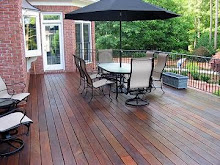The most commonly used material for decking is pressure-treated pine because it is the most inexpensive option. This type of wood is pressure-treated to extend the life and help protect it against insect infestation. The deterioration of the building industry has caused the price of this decking lumber to decrease over the last five years because the abundance of supply as a byproduct of paper production. Consumers will find that the lowest priced PT decking is not dry, which provides for a lot of shrinkage after installation. This often causes large gaps between the boards. Kiln-dried PT decking is the highest quality and shrinks very little after installation - but the cost is higher, negating the most attractive attribute of this decking. Although pressure-treated, the life expectancy of PT decking is short and the boards tend to splinter and rot much more quickly than the other decking options.
Medium priced decking options include cedar and redwood
lumber. These types of wood last longer than pressure-treated decking, but still
don’t come close to the long life expectancy of real hardwood decking. Unfortunately, wood-boring bugs LOVE to eat
cedar and redwood. However, deck installers find it easy to work with these
soft woods because any type of fasteners can be used.
Composite decking, a combination of plastic and wood fiber
pressed together, is one of the most expensive types of decking. Wood fiber is combined with plastic to help
give your deck more of a wood appearance and help stiffen the boards. The boards still are not as structurally
sound as wood. It is necessary to clean composite
decking with a strong mildew cleaner often because the wood fibers promote
mildew stains. These stains become
imbedded in the boards. Also, when the
moisture inside the boards freeze and expand, the boards deteriorate
quickly. These boards cannot be stained,
finished or refinished to revive the color as it fades.
Plastic, PVC and other oil-based manmade materials are also used
often in decking. This type of decking
comes in many different profiles, thicknesses, channel designs, pressed grain
patterns, colors and coatings. Manufacturers continually change their formulas to produce oil-based
decking, but none of them have successfully produced decking that will not
crack, fade, droop between joists or resist scratches. It cannot be finished to prevent loss of
color and once the color fades, it cannot be restored. Scratches cannot be repaired. Oil-based decking is most often touted as “maintenance
free” because there is no maintenance that will prevent fading, scratching and
drooping between the joists. Like
composite decking, oil-based manmade decking is one of the most expensive options. However, it burns VERY quickly . . . like
most plastic and oil-based products.
 |
|
RealWood™ Brazilian
Hardwood Decking vs. Composite Decking
|
Hardwood decking of ipe, cumaru, purple heart, massaranduba,
tigerwood and garapa are the most durable and most beautiful decking materials
in the world and cost less than manmade decking. They last a life time (40 – 100 years
depending on the species), bugs cannot eat it, it will never rot, and some of
the species have the same fire rating as concrete. One can preserve the color by applying a
protective deck oil finish periodically, and the color
can be restored if it grays after several years of being untreated. You cannot restore color fading with any
other decking material. Hardwood decking
is some of the hardest wood on the planet and will not droop between joists
when installed with proper joist spans. Scratches are easily repaired with a light sanding.
The least expensive of Brazilian hardwoods costs slightly
more than kiln-dried PT decking. Brazilian Wood Depot imports and stocks the largest variety of ipe decking, tigerwood, cumaru, and
more, plus you receive expert technical assistance. As more consumers become aware of this
beautiful and natural decking alternative, popularity continues to increase.











